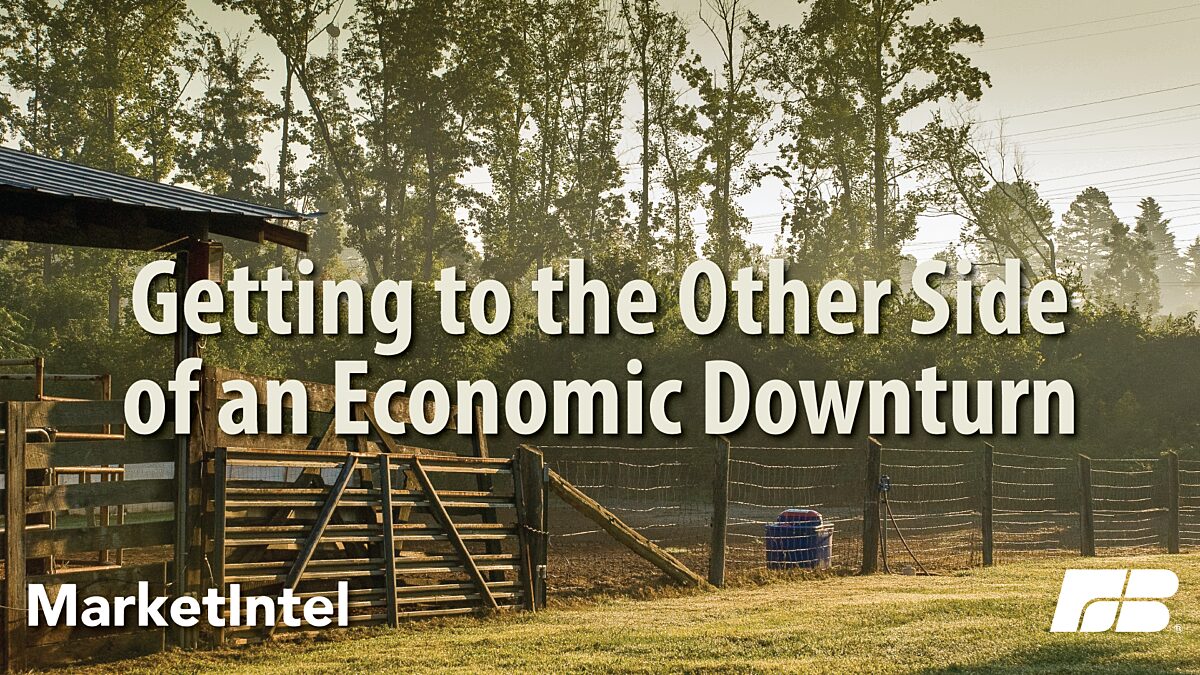Leading Your Family Farm Through Tough Times

Bernt Nelson
Economist
Though getting to the other side of a major economic downturn isn’t easy, there are leadership traits, actions and tools that can help farmers get there. As promised in a previous Market Intel, “The State of the Farm Economy and What it Means,” we’ll discuss some of the ways farmers and ranchers can bolster themselves and their businesses as they work through a financial situation that bears some instructive similarities to the 1980s farm crisis.
Leadership
About 88% of all farms are small, family-owned businesses, and combining family and business requires a special kind of leadership. Farming presents unique challenges—whether you’re growing corn in the Midwest, raising cattle in Texas, or producing citrus in Florida. Those challenges, the pressure and uncertainty, create some of the strongest, loyal, salt-of-the-earth leaders you will ever meet, much like how a diamond is formed under pressure of the earth. Leadership on the farm requires courage, empathy, accountability and a good attitude day-in and day-out. The greatest leaders develop a strong character and work to grow in these qualities consistently.
It’s not easy to lead a family business. Mounting pressures can create emotions that can cloud decision-making. To help prevent that from happening, a farm leader should develop the farm’s mission, vision and goals. These should be written and visible to provide a consistent, visual reminder when the path forward isn’t clear.
Mission
The farm’s mission should be present tense. This is the statement that defines what the farm does, how it does it, and why.
Vision
The farm’s vision is a statement about the future. It outlines where the business aspires to be. A helpful way to create a vision for the farm is to answer the question: “What should the farm look like in five years in my perfect world?” Organize this answer into general categories such as work-life balance, and financial goals. Then use the categories to write the vision statement.
Goals
Goal setting is an important and often overlooked leadership tool, which provides focus and direction. Goals help leaders focus on controllable variables and manage around uncontrollable ones. Good leaders have goals: great ones write them down. Writing down goals gives leaders—and those they are leading—a map. Goals can be set both short-term (six months to one year) or long-term (three years, five years or more). One good approach is to use the SMART goal system: Specific, Measurable, Achievable, Relevant and Time-bound.
Financial
The farm economy has entered a period of low returns and we don’t know how long it will last. Low incomes can result in lower levels of cash and working capital, requiring farmers to use other resources to remain financially stable. The financial decisions made during this time will determine the long-term sustainability of many American farms. The following are some tips that can help farm leaders make good financial decisions.
Write a Marketing Plan
While marketing decisions won’t be enough to offset lower prices, they are still important to managing income. One of the most important things a decision-maker can do is make a written marketing plan that includes all production costs and identifies the break-even price needed to cover those costs. Marketing plans should be flexible. A good marketing plan doesn’t need to be complicated and can serve as a benchmark for pricing products throughout the year. As sales are made, it’s important to keep records so that the decision-maker can learn whether the plan is working or should be adjusted. Remember, even the wrong paths can lead to the right places if we are willing to learn from mistakes.
Relationship Building
Develop a relationship with your ag lender and other third parties who can act as advisors. A farmer’s lender does far more than just provide credit. Ag lenders care deeply for their clients and can provide valuable financial advice. The more transparent and open you are with your ag lender, the better they can serve you, especially when tough circumstances arise.
Credit can provide liquidity when working capital is depleted. However, it’s important to use credit appropriately and understand the cost. Due to the high upfront cost of farming, a lot of farms rely on an annual operating loan for cash flow. If this isn’t enough, refinancing or term loans can be the next option. These options, while sometimes necessary, are costly and every time one of these is used, another lifeline gets taken off the table. Farm managers need to be sure that using these options is necessary and aligns with the written goals and vision of the farm.
Spending
The best managers are proactive about spending, including spending on family living. Family living is one of the more controllable expenses, but it can easily get away from you. Decisions about spending should reflect a dedication to goals and vision. If it doesn’t, you won’t accomplish the goals that would allow the farm to reach that vision.
Don’t waste money on unproductive assets. Years like this, when it’s all too easy to eat into working capital, are not a good time to spend money on something like a trial product that has little research supporting a claimed yield boost. Focus on profitability and margins, not chasing revenue and yield.
Top-tier producers with a proactive approach to spending tend to have lower rent and fertilizer costs. Many companies will price match their competitors, so shopping around for products like chemicals and fertilizer can pay off. Keep an eye out for pricing opportunities throughout the year because pre-buying can often save money.
Tough Circumstances
Often, tough circumstances are unforeseen and uncontrollable. Other times they may be a result of a decision. This might be a situation where a farmer has to decide whether or not to buy the land he’s been renting or risk losing it to a new owner, or it could be a natural disaster like the recent hurricanes or droughts Whatever the case is, these tough circumstances are the reason why it’s important to have your written goals, vision and mission to align your decisions with.
And when disaster strikes, seek out available government assistance and keep good records so it’s easy to apply for that assistance when it becomes available.
Hurricanes Helene and Milton have created devastating and unimaginable circumstances for many people. For information on how to support victims, please visit our Hurricane Relief Webpage.
Farm State of Mind
Farming is stressful and comes with increased levels of anxiety and depression. Multiple studies show that farmer suicide rates are two-to-five times higher than the national average. According to an American Farm Bureau Federation survey, 91% of farmers and farmworkers believe that financial issues impact their mental health. According to the same survey, 87% of farmers and farm workers believe that fear of losing the farm impacts their mental health.
The American Farm Bureau Farm State of Mind campaign builds awareness to reduce stigma and provides access to information and resources that promote farmer and rancher mental health wellness. One of the Farm State of Mind resources provided by the Farm Family Wellness Alliance, including AFBF, is Togetherall, a safe, anonymous, online peer-to-peer community available 24/7. These mental health and wellbeing services provide a nationwide safety net of confidential and on-demand support to farmers, ranchers and farm families in the United States.
Conclusions
Many farmers are struggling to keep their heads above water in this farm economy. But there are actions farmers can take to help them lead their businesses and families through the hard times and become a sustainable business for generations to come. Great leaders write down marketing plans, goals and visions for the farm. They calculate spending and avoid investing in unproductive assets, especially when cash flow is not abundant. Lastly, they develop relationships with their third-party advisors such as their lender. Doing these things takes courage, and when done consistently, can help lead farms through the down ag economy.
Top Issues
VIEW ALL
